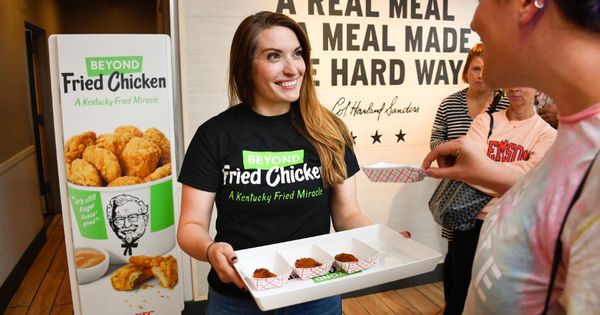

Beyond Meat building a powerful brand using plant based food. (John Amis/AP Images for Beyond Meat)
ASSOCIATED PRESS
If you are going to launch or market a company, you may as well try and build such a powerful brand that it creates tremendous brand equity. The difference could be worth billions. For example, global brand expert Kevin Keller cites PepsiCo, which has a net tangible book value of $6.5 billion but a market value of over $90 billion. Keller attributes about $83 billion of that market valuation to intangible assets, and more specifically, to PepsiCo’s brand equity.
A branding strategy helps establish a product within the market and to build a brand that will grow and mature in a saturated or even growing marketplace. Making smart branding decisions up front is crucial since a company may have to live with the decision for a long time. In order to consider what might be the right branding strategy for your company, here are commonly used branding strategies:
COMPANY NAME. In this case a strong brand name (or company name) is made the vehicle for a range of products (for example, Mercedes Benz or Black & Decker) or a range of subsidiary brands like YUM Foods which owns Taco Bell, KFC and Pizza Hut.
INDIVIDUAL BRANDING. Each brand has a separate name, putting it into a de facto competition against other brands from the same company (for example, Kool-Aid and Tang are both owned by Kraft Foods). Individual brand names naturally allow greater flexibility by permitting a variety of different products, of differing quality, to be sold without confusing the consumer’s perception of what business the company is in or diluting higher quality products.
ATTITUDE BRANDING AND ICONIC BRANDS. This is the choice to represent a larger feeling, which is not necessarily connected with the product or consumption of the product at all. Companies that use attitude branding include: Nike, Red Bull, The Body Shop, and Apple, Inc. Iconic brands are defined as having aspects that contribute to the consumer’s self-expression and personal identity.
BRAND IDENTITY VALUE. Brands whose value to consumers comes primarily from having identity value are said to be “identity brands.” Some brands have such a strong identity that they become “iconic brands” such as Patagonia, Coca Cola, Visa, and Harley Davidson.
DERIVED BRANDS. Some suppliers of key components may wish to guarantee their own position by promoting that component as a brand in its own right. For example, Intel, positions itself in the PC market with the slogan (and sticker) “Intel Inside.” Gore-Tex positions itself and its product formula as a protector of products through waterproofing other brands clothes.
Intel Inside logo on PC desktop box. (AP Photo/Gene J. Puskar)
ASSOCIATED PRESS
BRAND EXTENSION AND BRAND DILUTION. The existing strong brand name can be used as a vehicle for new or modified products. For example, many fashion and designer companies extended brands into fragrances, shoes and accessories, furniture, and hotels. Frequently, the product is no different than what is already on the market, except it has a brand name marking. The risk of over-extension is brand dilution, which is when the brand loses its brand associations with a market segment, product area or quality, price, or cachet.
MULTI-BRANDS STRATEGY. Alternatively, in a very saturated market, a supplier can deliberately launch totally new brands in apparent competition with its own existing strong brand (and often with identical product characteristics) to soak up more market share. The rationale is that having 4 out of 12 brands in such a market will give a greater overall share than having 1 out of 10. Procter & Gamble is a leading exponent of this philosophy, running as many as ten detergent brands in the US market. In the hotel business, Marriott uses the name Fairfield Inns for its budget chain. Cannibalization is a particular problem of a multi-brands strategy approach, in which the new brand takes business away from an established one which the organization also owns. This may be acceptable (indeed to be expected) if there is a net gain overall.
PRIVATE LABEL BRANDING. Also called own brands, or store brands, these have become increasingly popular. When the retailer has a particularly strong identity, this “own brand” may be able to compete against even the strongest brand leaders and may outperform those products that are not otherwise strongly branded. Costco does this with its “Kirkland” brand and Trader Joes sells its own house brand throughout its stores.
INDIVIDUAL AND ORGANIZATIONAL BRANDS. These are types of branding that treat individuals and organizations as the products to be branded. Personal branding treats persons and their careers as brands. Be careful here though, because if the individual has a problem, the brand has a problem. This has worked well for Campbell Soups but hurt Subways when they associated an individual as the face of the brand and then that individual was charged with a crime.
CROWDSOURCING BRANDING. These are brands that are created by the people for the business, which is opposite to the traditional method where the business creates a brand. This type of method minimizes the risk of brand failure, since the people that might reject the brand in the traditional method are the ones who are participating in the branding process. Think of Yelp, Instagram, Craigslist, and perhaps Etsy.
read more at http://www.forbes.com/entrepreneurs/ by Bernhard Schroeder, Contributor
Business









